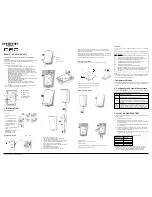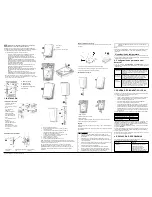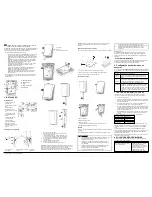
D-306633 PGx914 Installation Instructions
1
PG4914 / PG8914 / PG9914
PowerG Wireless, PIR/Pet Immune Motion Detector Installation
Instructions
The PGx914 (pet immune) is a microprocessor-controlled wireless digital PIR
detector supported by DSC alarm systems using PowerG two-way
communication protocol.
The detector's features are as follows:
l
Fresnel and cylindrical lenses with uniform detection sensitivity
throughout its operating range, up to 12 meters (39 ft).
l
Target Specific Imaging™ (TSI) technology is used for distinction
between humans and pets weighing up to 38 kg (85lb).
l
The advanced True Motion Recognition™ algorithm (patented)
distinguishes between the true motion of an intruder and any other
disturbances which may cause false alarms.
l
No vertical adjustment is needed.
l
Motion event counter determines whether 1 or 2 consecutive
motion events trigger an alarm.
l
Very low current consumption.
l
Microprocessor-controlled temperature compensation. Sealed black
chamber provides white light protection.
l
Front and back tamper protection.
l
The device supports temperature and light level reports to
compatible alarm systems that support temperature and light
sensors.
For UL installations: The detector is for use with UL listed control units
only. Pet immunity has not been evaluated by UL.
A. Enroll button
B. Light sensor
C. LEDs
D. Tamper switch
E. PIR sensor
Internal View
1. INSTALLATION
General Guidance
1. Keep away from heat
sources.
2. Do not expose to air
drafts.
3. Do not install outdoors.
4. Avoid direct sunshine.
5. Do not install near high-
voltage electrical lines.
6. Do not install behind
partitions.
7. Mount on a solid stable
surface.
Warning!
Do not partially or
completely obscure the
detector's field of view.
Installation
Procedure
A: Surface mount
B: Corner mount, B1 or B2
C: Back tamper
D: Cover
E: Base
F: Press in point
1.
Mount the bracket on the wall.
2.
Press in the point marked "F" in the drawing and
separate the cover from the base.
3.
Insert the battery while observing polarity-OR- If battery
is already installed, remove the activation strip that
protrudes from the front of the detector.
4.
Return the cover to the base until a click is heard (the
snap is closed).
5.
Secure the detector with the screw.
6.
Align the detector with the bracket.
7.
Slide the detector upward until a click is heard.
Note:
The detector transmits a low battery signal upon detection of low
voltage. It is recommended to wait about 1 minute after battery removal,
before inserting the new battery.
PGx914 shall be installed in accordance with the Standard for Installation and
Classification of Burglar and Holdup Alarm Systems, UL 681.
Caution!
Risk of explosion if battery is replaced by an incorrect type. Dispose
of used battery according to the manufacturer's instructions.
Removing the Pet Mask
Remove the plastic pet mask if you do not require pet immunity.
1. Place your thumb at the base of the Pet Mask.
2. Place your fingers at the top of the Pet Mask.
3. Lift the Pet Mask to remove.
Disassembly from Bracket
1. Release screw.
2. Separate the cover from the base.
3. Remove battery.
4. Press on the stopper snap to release the base from the bracket.
5. Slide the base downward to remove.
Enrollment
See the alarm systems Installation Guide and follow the enrollment
procedure.
A general description of the procedure is provided in the following flow chart.
Step Procedure
1
See the Installation Manual for the alarm system that the device is
being enrolled on, to ensure that the proper steps are used.
2
Enter the Device Enrollment option through the specified method
and select the appropriate option to add a new device.
3
Enroll the device by either holding the enroll button until the
enrollment is detected, or by entering the Device ID.
4
Select the desired Zone Number.
5
Configure any device parameters that are required.
6
Mount and test the detector. See section 3 for information on testing
the device. In addition, see the alarm systems Installation Manual
that the device is enrolled on for other test procedures that are
required.
Note:
If the detector is already enrolled, you can configure the detector parameters
by programming the system, see the alarm systems Installation Manual for
more information about device parameters.
Temperature Display
For instructions on displaying the temperature of zones on the control panel
as measured by PGx914 detectors, see the alarm systems Installation Manual
for details.
2. Configuring the Detector Parameters
Enter the
DEVICE SETTINGS
menu and follow the configuration instructions
for the PGx914 detector as described in the following table.
Option
Configuring Instructions
Alarm
LED
Define whether or not the alarm LED indication will be activated.
Optional settings: LED ON (default) and LED OFF.
Event
Counter
Define whether an alarm will be activated upon continued
motion (low sensitivity) or upon a single alarm event (high
sensitivity). Optional settings: LOW sensitivity (default) and HIGH
sensitivity.
High
Traffic
Shutdown
Define whether or not the sensor is active when the system is
disarmed. Optional settings: NOT Active while disarmed
(default), - no delay, 5s delay, 15s delay, 30s delay, 1m delay,
2m delay, 5m delay, 10m delay, 20m delay and 60m delay.
3. LOCAL DIAGNOSTICS TEST
Note: Run a diagnostic test at least once a week to ensure that the detector
is working correctly.
1.
Separate the base from the cover .
2.
Replace the cover to return the tamper switch to its normal
(undisturbed) position, and then secure the front cover to the base with
the case closure screw.
3.
The PGx914 detector will enter a 2 min. stability period. During this time
the red LED blinks.
4.
Walk-test the coverage area.Walk across the far end of the coverage
pattern in both directions. The red LED lights each time your motion is
detected followed by 3 LED
blinks.
Important!
Instruct the user to walk test at least once a week to verify
proper functioning of the detector.
The following table outlines received signal strength indication:
LED response
Reception
Green LED blinks Strong
Orange LED blinks Good
Red LED blinks
Poor
No blinks
No communication
Important!
Reliable reception must be assured. Therefore,
poor
signal
strength is not acceptable. If you receive a
poor
signal from the device, re-
locate it and re-test until a
good
or
strong
signal strength is received.
For UL/ULC installations, only
STRONG
signal level are acceptable.


























